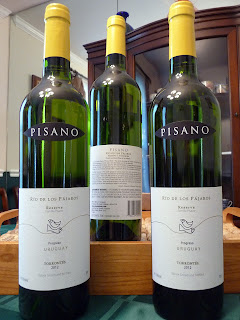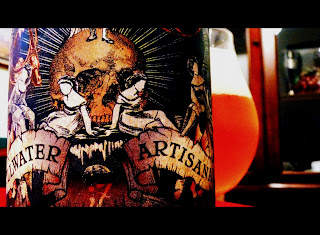One of the greatest things about a wine club, apart from the fun time spent with great friends, are the challenges. Very rarely are challenges expressly stated. They are often implied. For example, when the host couple decides to prepare a Malaysian BBQ dinner, it creates a challenge for the couple who is tasked with pairing wines to each course. That challenge was presented to my beautiful Angel and myself.
To add to the challenge, I did not have as much time as I would have liked to research each potential pairing. With our newest arrival, I have not had nearly as much time to cook, work on the blog or just read about food. (This is not a complaint, because I love our new son and enjoy every moment that I have with him and Clare.) Still, with less time to prepare, it required a little more faith and gut-checking when it came to the selection of the wine. I was able to come to a rather quick decision on the wine styles and/or grapes, but the actual choice of wines would prove a little more difficult.
Familia Pisano - Río de los Pájaros Torrontés Reserve (2012)
Paired with Grilled Turmeric and Lemongrass Chicken Wings
For the first course, the host couple prepared Grilled Turmeric and Lemongrass Chicken Wings. As I reviewed the recipe, I immediately focused upon the ingredients that would need to considered when it came to the pairing. Ingredients like turmeric, lemongrass, fish sauce, lime juice and ginger.
I immediately began to think that a white wine would seem to be particularly appropriate, given the citrus flavors, the turmeric and the chicken. A fruity wine, like a Pinot Grigio or a Vinho Verde, would not stand up to the earthiness of the turmeric or the fish sauce. A smoother white wine was needed. I originally thought of a Viognier, which has been served at quite a few wine club dinners in the past.
However, as I stood in the wine store, none of the Viognier wines caught my eye. Instead, a different wine caught my attention. Actually, it was the winemaker who caught my attention ... Familia Pisano. I was staring at their Río de los Pájaros Torrontés Reserve (2012). I have previously tried the Pisano
Cabernet Sauvignon (2009), which is a very good wine. I also have a bottle of the Tannat sitting in my wine cage for the right time. So, I decided to go with the Torrontés as the pairing for the first course.

The Torrontés is a white grape varietal that is principally grown in Argentina, although it can also be found in Chile and, in the case of the Familia Pisano, from the "River of the Painted Birds" or Uruguay as it is known in the native language of the Guarani, Uruguay's native inhabitants. The Pisano family can trace their winemaking history back to 1870, when their great grandfather emigrated to Uruguay from Italy. The vineyards and winery passed down the generations to three brothers -- Daniel, Eduardo and Gustavo Pisano-Arretxea.
This wine comes from their the Río de los Pájaros selections, which includes the Cabernet Sauvignon and the Tannat. This particular Río de los Pájaros is produced with 100% Torrontés. The wine pours a clear golden color, and had an aroma of citrus (such as lemon or lime), with a floral element. The taste of the was was principally peach and citrus flavors, although there was a slight hint of honey and minerality in the background.
This wine was a great start to the evening because it paired very well with the delicious marinade used to make the chicken wings. It was also my favorite wine of the night.
McManis Family Vineyards - Pinot Noir (2010)
Paired with Steak Skewers with Scallion Dipping Sauce and
Grilled Shrimp with Chile, Cilantro and Lime
The second course actually consists of two completely different courses. One course, for the carnivores in the group, is Steak Skewers with Scallion Dipping Sauce. The steak is marinated in among other things, fish sauce, lime juice, Thai chiles, lemongrass and ginger. These are some potent flavors, both in terms of taste and heat. The other course is grilled shrimp with chiles (long red chiles), cilantro and lime.
The wine for this course has to be able to reach across both red meat and seafood. This is a fairly difficult task for most red wines, because they can be somewhat difficult to pair with seafood. There is one wine, however, that can bridge that gap between land and water with relative ease ... a Pinot Noir. The only question is which one. Although a real pain to cultivate, there are several very good countries and regions around the world that produce some very good Pinot Noir wines. Countries like France, and regions like the Willamette Valley in Oregon.
However, we are working with a budget, which eliminates almost all of the good French Pinot Noirs and all of the Oregonian wines. As I stood in the wine store contemplating my options, I saw a wine from a vineyard that both Clare and I really like. The vineyard is the McManis Family Vineyards. We are very big fans of the Petit Sirah, but that wine would probably be too forward for this dish, especially with respect to the shrimp. We did see a bottle of the McManis Pinot Noir, which I have never had before. So, we chose that wine to pair with the second course.

This particular wine is produced in California, which, from my experience, makes Pinot Noirs that are a less earthy and spicy than the wines from Oregon. Californian Pinot Noirs then to be a little more fruit forward than their Oregonian counterparts. That fruitiness was what I was looking for with respect to the pairing.
The 2010 vintage, according to the winemakers provides a garnet color. I was a little concerned about the color, looking at the wine in the bottle. However, my concerns were laid to rest. The color is definitely a nice shade of red. The wine did have aromas of fresh berry fruit, particularly raspberry with perhaps some strawberry. The winemakers also suggest that there is a "subtle waft" of vanilla from the aging of the wine for six months in French oak barrels. I sensed a little of the oak, but the fruit was definitely the principal aromatic element in the wine (as it should be). The taste of the 2010 Pinot Noir was just as the winemakers described it: "mouth-watering cherry flavors" with "creamy mocha" lingering on the finish. The oak aging was also present in the background of the wine, although it was not very noticeable.
Overall, we thought this wine would be a little lighter than the Oregonian type of Pinot Noir and a little more fruit forward with few to no tannins. We were correct, as it paired very well with both the shrimp and the meat, as well as tame the heat from the Thai chiles and red peppers.
Marques de Monistrol - Seleccion Especial Cava
Malaysian Banana Pancakes with Sweet Corn Ice Cream
For the third and final course, the host couple made Malaysian Banana Pancakes with Sweet Corn Ice Cream. This course was perhaps the hardest one to pair. What wine goes with Banana Pancakes? My thoughts instantly turned to dessert wines, but I could not really decide which dessert wine would be the best pairing for this course. I was also concerned that the wines may be too sweet, which may be a little too much when one considers the flavors of the banana and the ice cream. I had to change my thought process if I was going to decide upon a wine for the last course.
Ultimately, the thought process was as follows. Pancakes could be served as part of a brunch. Mimosas are often served at brunch. Mimosas are made with Champagne or sparkling wine. Cava is a sparking wine produced in the Catalunya region of Spain using the methode Champenoise. As I perused the offering of Cava wines at the store, I came across the Marqués de Monistrol Cava, which I thought would work well for the final course of the Malaysian BBQ dinner.
Like the Familia Pisano, Marqués de Monistrol can trace its history back to the nineteenth century, when its winemaking operations were first established at a property in San Sadurni d’Anoia in 1882, which is located
in the heart of Penedès. This is right in the middle of the Cava region.
Cava wines are principally made with three varietals ... Macabeo, Xarel-lo and Parellada, although the rules allow winemakers to use a fourth grape -- Chardonnay -- in the production of the wine. The Marqués de Monistrol is made with three standard grapes (Macabeo, Xarel-lo, and Parellada).
The Marqués de Monistrol Cava has a bright straw color when poured. The aromas included apples, fresh herbs, and even a little pear. As I tasted the wine, it was like a basket of fresh apples in every sip. While I could not identify the exact apple, that taste element was very good and, with the carbonation, very refreshing. There finish on the wine was a little dry, as expected.
The apples in the flavor of this Cava seemed to work very well with the flavors of the banana pancake and balanced out the sweetness in the ice cream. This winwine has been described as having a bright straw colour, fresh aromas of herbs and apples and a full and long on the finish with a fine mousse. A mousse finish seems appropriate for banana pancakes.
* * *
In the end, I think all three the pairings worked out well. I was particularly pleased with the first and second pairings, but the third pairing effectively worked too. I have to give myself a little leeway with the third one because it is a little hard to pair wines to banana pancakes and sweet corn ice cream. The most important thing is that everyone had a great time. The food was amazing and the wines were very good as well. Until next time ...
ENJOY!





























